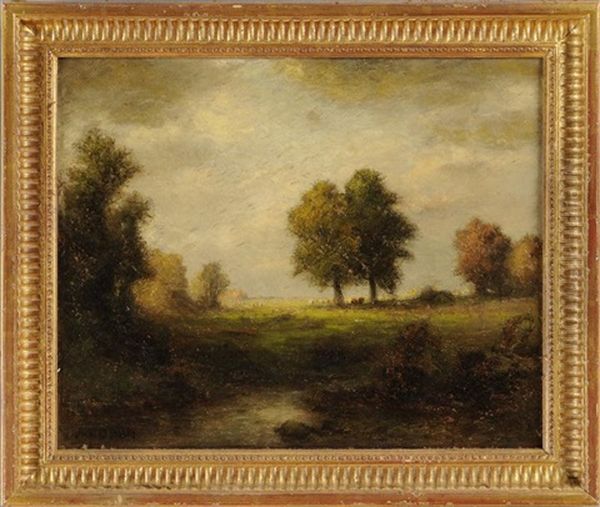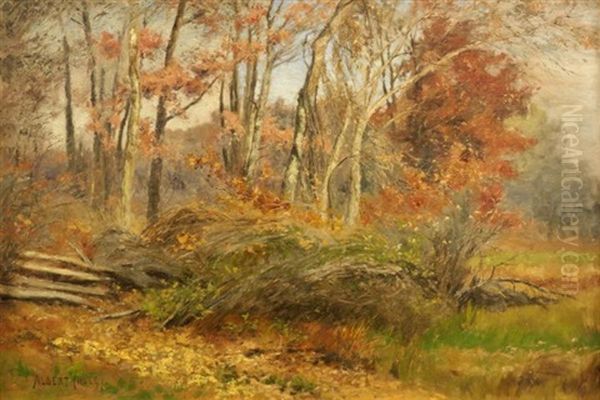Albert Babb Insley stands as a dedicated figure in American art history, a painter whose long career spanned a period of significant transition in landscape painting. Born on April 1, 1842, in Jersey City, New Jersey, and passing away in New York in 1937 at the venerable age of 95, Insley devoted his life to capturing the nuances of the natural world, particularly the landscapes and marine scenes of the American Northeast. His work reflects the pervasive influence of the French Barbizon school, adapted to an American context, showcasing a sensitivity to light, atmosphere, and the quiet dignity of nature.
Early Life and Artistic Awakening
Insley's journey into the world of art began under the influence of his own family. He was the third child of Henry Earl Insley and Sarah Ann Fletcher Insley. His father, Henry Earl Insley, was a notable figure in the nascent field of American photography, recognized as one of the early pioneers of the daguerreotype process and among New Jersey's first practitioners of dry-plate photography. This environment undoubtedly fostered an appreciation for visual representation in the young Albert.
His artistic inclinations surfaced early. By the age of fourteen, Insley had already secured his first significant commission: a painting for the Llewellyn Park Estate in New Jersey. This early success signaled a promising future. He initially followed in his father's footsteps, learning the techniques of photography under his guidance. This training likely honed his eye for composition and detail, skills that would serve him well in his later painting career. In 1860, he undertook photographic excursions to the scenic areas of Green Mountain and Waterville in New Hampshire, further immersing himself in the landscapes that would become his primary subjects.
Formal Training and Transition to Painting

While photography provided an initial pathway, Insley's true passion lay in painting. He sought formal training to develop his skills, studying at the prestigious National Academy of Design in New York City. During his time there, he may have studied under figures such as Professor Homer E. Newell, absorbing the academic traditions and techniques taught at the institution. The National Academy was a central hub for American artists, and his education there placed him within the mainstream of the New York art world.
By the 1860s, Insley had committed himself to becoming a full-time artist, transitioning from photography to focus primarily on oil painting. His early photographic trips likely informed his choice of subjects, as he developed into a respected painter known for his depictions of landscapes, particularly those capturing the character of New England and the surrounding regions. He embarked on sketching trips, immersing himself directly in the environments he wished to portray, a practice common among landscape painters of his era.
Artistic Style: The Barbizon Influence
Albert Babb Insley's artistic style is most strongly associated with the influence of the French Barbizon School. This movement, which emerged in France around the 1830s near the Forest of Fontainebleau, emphasized realism, a deep appreciation for nature, and the depiction of rural landscapes and peasant life. Artists like Jean-Baptiste-Camille Corot, Jean-François Millet, Théodore Rousseau, and Charles-François Daubigny moved away from idealized, classical landscapes towards more intimate, atmospheric, and directly observed scenes.
Insley absorbed these principles into his own work. His paintings are characterized by a focus on the effects of light and shadow, a subtle and often tonal color palette, and meticulous attention to the details of the natural world. He sought to capture the mood and atmosphere of a scene rather than just its topographical accuracy. Sources suggest he experimented with his medium, sometimes using turpentine to thin his paints, achieving a lighter, more fluid application, and incorporating a richer array of greens into his landscapes, reflecting the lushness of the environments he depicted.
While influenced by the Barbizon aesthetic, Insley's work also existed within the broader context of 19th-century American landscape painting. His career overlapped with the later stages of the Hudson River School, whose proponents like Thomas Cole, Asher B. Durand (a former president of the National Academy), Frederic Edwin Church, and Albert Bierstadt often focused on grand, panoramic, and sometimes idealized views of the American wilderness. Insley's approach, however, tended towards the more intimate, contemplative, and atmospheric style favored by the Barbizon painters and their American followers.
A Career Centered in New York

New York City served as the epicenter of Insley's long artistic career. He became an active participant in the city's vibrant art scene. For an impressive 48 years, he lived and worked in the famed Tenth Street Studio Building. This building was a significant hub for artists in the latter half of the 19th century, housing studios for many prominent figures, including Frederic Edwin Church, Albert Bierstadt, and later, William Merritt Chase. Insley's extended tenure there placed him at the heart of artistic life in New York.
His involvement extended to exhibiting his work regularly. From the 1860s through the late 1890s, Insley was a frequent exhibitor at the National Academy of Design, the very institution where he had trained. Records indicate he showed his work there numerous times, possibly as many as 36 occasions between 1868 and 1898, establishing a consistent presence. He also exhibited extensively with the Brooklyn Art Association between 1869 and 1891, further solidifying his reputation within the regional art community.
Insley's engagement with the art world also included teaching. He served as an instructor at the Art Students League of New York, sharing his knowledge and skills with younger generations of artists. His connections within the artistic community were broad. He is known to have associated with fellow landscape painter Jasper Cropsey, another artist known for his vibrant depictions of American scenery. He also reportedly had connections or collaborations with artists such as Henry L. Hillier and the internationally renowned portraitist John Singer Sargent, indicating his integration into diverse artistic circles. Furthermore, he maintained a supportive relationship with Samuel F.B. Morse, the inventor and accomplished painter who had been a key figure in establishing the National Academy of Design.
Professional Roles and Affiliations
Beyond his activities as a painter and teacher, Albert Babb Insley took on significant administrative and community roles within the art world, demonstrating a commitment to the institutions that supported artists. His long association with the Brooklyn Art Association was particularly notable. Sources indicate he served as the association's Gallery Director for a period of 18 years, playing a key role in organizing exhibitions and managing the gallery's operations. Other accounts suggest he held the position of President of the association for an extended period, possibly as long as 39 years, highlighting his leadership and dedication.

His participation in artistic organizations extended further. He was a member of several prominent groups, including the New York Camera Club, reflecting his early background and continued interest in photography. He was also affiliated with the Pratt Institute Art Association and the Nassau County Art League on Long Island, indicating his engagement with artistic communities beyond Manhattan and Brooklyn. These affiliations underscore his active role and respected standing within the broader artistic landscape of the New York metropolitan area.
Notable Works and Artistic Themes
While Insley produced a substantial body of work over his long career, one painting often cited as representative is titled Summer Landscape. This work exemplifies his focus on natural scenery and likely showcases his Barbizon-influenced style, emphasizing atmosphere and the quality of light. Works like Summer Landscape have appeared in the art market and exhibitions over the years, attracting attention from collectors and institutions. For instance, Antiques and The Arts Weekly reported on the exhibition of an Insley Summer Landscape at an Antiques Show hosted by the Massachusetts Horticultural Society, indicating continued interest in his work.
Insley's primary subjects were landscapes and marine scenes. He drew inspiration from the natural beauty of New Jersey, New York, and the New England states. His canvases often depict tranquil woodland interiors, coastal views, river scenes, and pastoral landscapes. He excelled at capturing the specific qualities of light and atmosphere associated with different times of day and seasons. His dedication to direct observation, combined with the Barbizon sensibility, resulted in works that convey a sense of place and a quiet reverence for the natural world.
Legacy and Recognition
Albert Babb Insley lived a long and productive life dedicated to his art. He witnessed significant shifts in the art world, from the dominance of the Hudson River School through the rise of Impressionism and beyond, yet he remained largely consistent in his Barbizon-inspired landscape approach. His career was marked by steady participation in major exhibitions, involvement in key art institutions, and the creation of a substantial body of work appreciated for its sensitivity and technical skill.
His life and career have been documented, most notably in the book In Twilight of the Hour - Albert Babb Insley (1842-1937): An Artist’s Life and Career in New York. This publication provides a detailed examination of his artistic journey, his time in New York, his teaching activities, and his connections within the art community. Unlike some artists whose lives are marked by dramatic events, Insley's known history appears to be one of consistent dedication to his craft, without significant public controversy.
He passed away in 1937, leaving behind a legacy as a skilled and respected American landscape painter. His work provides valuable insight into the influence of the Barbizon movement on American art and represents a significant contribution to the tradition of landscape painting in the late 19th and early 20th centuries. His paintings continue to be appreciated for their tranquil beauty and their earnest engagement with the American landscape.
Conclusion
Albert Babb Insley navigated the American art scene for over seven decades, establishing himself as a proficient and sensitive interpreter of the natural world. Rooted in the photographic precision likely inherited from his father and formally trained at the National Academy of Design, he found his mature voice through the lens of the Barbizon School. His dedication to capturing the subtle interplay of light, atmosphere, and detail in the landscapes of the Northeast, combined with his active participation in the New York art world through teaching, exhibiting, and institutional leadership, marks him as a noteworthy figure. While perhaps not as revolutionary as some of his contemporaries, Insley's consistent output and commitment to his artistic vision earned him a respected place in the annals of American landscape painting.